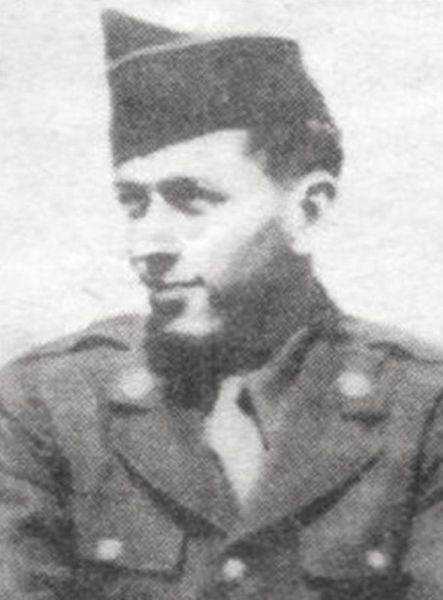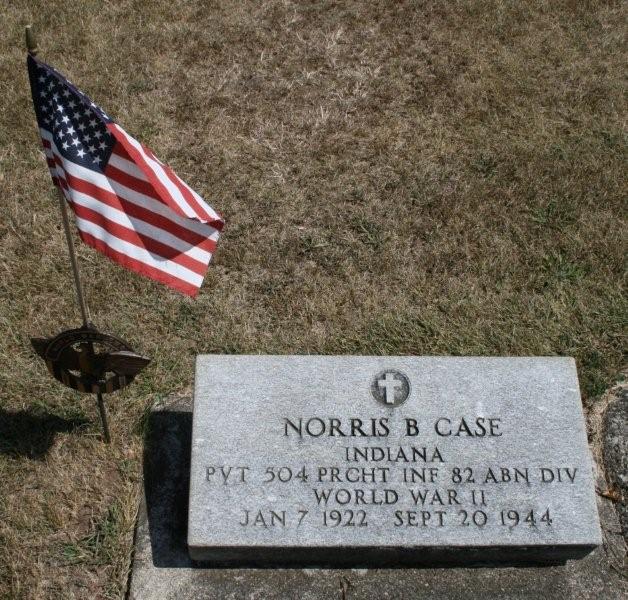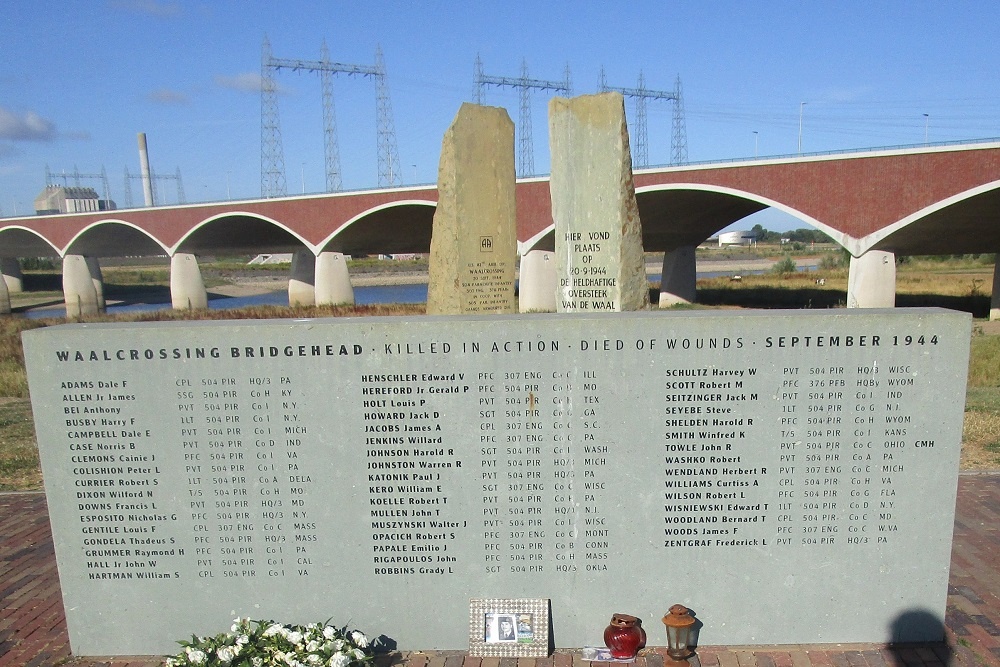Case, Norris B.
- Date of birth:
- January 7th, 1922 (Wolcotville-LaGrange County/Indiana, United States)
- Date of death:
- September 20th, 1944 (Nijmegen, the Netherlands)
- Service number:
- 35346780
- Nationality:
- American
Biography
Norris B. Case was born on January 7, 1922, in Wolcottville/LaGrange County, Indiana, the United States of America. He was the oldest son of Andrew Perry and Agnes Vietta (Reade) Case and had two younger brothers and a little sister. Next to attending school, he was a busy teenager; he picked apples, ran a milk route and was the student manager of the basketball team of his high school. He also went hunting a lot with his brother Don. In 1921 he graduated from Wolcottville High School and went to work at Clarks Restaurant in South Bend, St Joseph. On June 14, 1942, he married Donna Alene Wintz.
On November 21, 1942, Norris enlisted in the US Army. Early 1943, after finishing his basic training, he went through parachute-training and became a trooper. He was assigned to D Company, 2nd Battalion, 504th Parachute Infantry Regiment (PIR), 82nd Airborne Division ‘All American’. In April 1943, his regiment, with private Case, was shipped to French Marocco, North Africa, to prepare for the battle in Hitler-Europe. In July he participated in the liberation of Sicily (operation Husky); In September in the landing at Salerno (operation Avalanche) and thereafter the push north of Naples in the direction of Rome. In January 1944, Norris participated in the landing at Anzio (operation Shingle). On April 10, 1944, the 504th PIR, with Norris, left Italy to join the rest of the 82nd Airborne Division in England where they arrived on April 22. However, the regiment had suffered too severe personnel losses and it couldn’t get enough replacements, which hampered it to take part in operation Overlord, D-Day on June 6. The regiment had instead to prepare for the next major operation, in the Netherlands, operation Market Garden.
Private Norris B. Case, jumped on September 17, 1944, in the early afternoon, as radio operator in the 2nd Platoon, D Company, 2nd Battalion, 504th Parachute Infantry Regiment, near Overasselt. After landing, they moved west as quickly as possible, to seize the bridge over the river Maas in Grave. This was the primary objective of the 2nd Battalion, where E Company jumped south of the river and F and D companies (with Norris) north of the Maas. Within just a few hours after landing and some short gunfire exchanges, the bridge was seized. Then the 2nd Battalion had to expand its sector and strengthen its defensive positions around the bridge. After this, they had to wait on their relief by English ground forces which arrived on September 19. That evening the 3rd Battalion, led by Major Julian Aaron Cook, was ordered to prepare for a river crossing by canvas boats the next day, September 20. The 2nd Battalion was ordered to sweep and secure the southern bank of the river Waal at the NYMA factory terrain and take up fire positions in order to cover Cooks battalion during their river crossing.
D Company, with Norris, was the first unit to arrive and sweep the bank. After they marched 8 miles from Grave, via Hees, to the NYMA terrain, they could set up their fire positions in the early morning of September 20. 2nd Platoon, led by 1st Lieutenant Edward Wisniewski, had to secure the NYMA terrain. Suddenly German forces across the river opened up and Lt Wisniewski was hit. He was laying several dozen yards away from his men, in plain view of the enemy. Norris twice tried to rescue his platoon leader, but was driven back, both times, by heavy enemy machine gun, rifle and artillery fire. The third attempt succeeded to reach his lieutenant, however, while giving first-aid, he got mortally wounded himself by shrapnel. Private Norris B. Case died at 22 years of age. His platoon leader would die of his wounds a few days later.
Norris was posthumously awarded the Bronze Star Medal, for his heroic and selfless actions under heavy enemy fire that morning. He also received a Purple Heart. Initially he was buried in Molenhoek, near Nijmegen. After World War II his remains were repatriated, in April 1949, and reburied at Woodruff Cemetery in Johnston Township, Indiana, the US.
Do you have more information about this person? Inform us!
- Period:
- Second World War (1939-1945)
- Rank:
- Private
- Unit:
- Radio Operator, Company D, 2nd Battalion, 504th Parachute Infantry Regiment, 82nd Airborne Division "All American", U.S. Army
- Awarded for:
- Operation Market Garden
"For heroic action on 20 September 1944, about one mile from NIJMEGEN, Holland. When his platoon leader was wounded and lay in an exposed position under heavy enemy fire, Private Case, Platoon Radio Operator, Company "D", 504th Parachute Infantry, voluntarily endeavored to rescue this officer. In his first two attemps he was driven back by heavy machine gun, rifle, and artillery fire, but on his third attempt he reached his Platoon Leader. While rendering first-aid he was himself wounded by shrapnel. Throughout his rescue attempts, Private Case did not desert his duties as radio operator, but continued to keep his company commander informed of the enemy situation. By his unselfish and voluntary action in the face of great danger, Private Case typified the highest traditions of the service."
Awarded posthumously.
- Period:
- Second World War (1939-1945)
- Rank:
- Private
- Unit:
- Radio Operator, Company D, 2nd Battalion, 504th Parachute Infantry Regiment, 82nd Airborne Division "All American", U.S. Army
- Awarded for:
- Operation Market Garden
- Period:
- Second World War (1939-1945)
- Rank:
- Private
- Unit:
- D Company, 2 Battalion, 504 Parachute Infantry Regiment, 82nd Airborne Division
- Period:
- Second World War (1939-1945)
- Rank:
- Private
- Unit:
- D Company, 2 Battalion, 504 Parachute Infantry Regiment, 82nd Airborne Division
- Period:
- Second World War (1939-1945)
- Rank:
- Private
- Unit:
- D Company, 2 Battalion, 504 Parachute Infantry Regiment, 82nd Airborne Division
- Period:
- Second World War (1939-1945)
- Rank:
- Private
- Unit:
- D Company, 2 Battalion, 504 Parachute Infantry Regiment, 82nd Airborne Division
- Period:
- Second World War (1939-1945)
- Rank:
- Private
- Unit:
- D Company, 2 Battalion, 504 Parachute Infantry Regiment, 82nd Airborne Division
- Period:
- Second World War (1939-1945)
- Rank:
- Private
- Unit:
- D Company, 2 Battalion, 504 Parachute Infantry Regiment, 82nd Airborne Division
- Period:
- Second World War (1939-1945)
- Rank:
- Private
- Unit:
- D Company, 2 Battalion, 504 Parachute Infantry Regiment, 82nd Airborne Division
- Period:
- Second World War (1939-1945)
- Rank:
- Private
- Unit:
- D Company, 2 Battalion, 504 Parachute Infantry Regiment, 82nd Airborne Division
Sources
- Photo 1: Findagrave.com by Peter Hakze
- Photo 2: Findagrave.com by Jean Fremion Litke
- - LUNTEREN, F. VAN, Spearhead of the fifth army, Casemate, Havertown USA & Oxford UK, 2016.
- LUNTEREN, F. VAN, The Battle of the Bridges, Casemate, 2017.
- NORDYKE, P., All American All the Way, Zenith Press, St. Paul, United States, 2005.
- STEENBERGER, D. e.a., De Oversteek, De Gelderlander, Nijmegen, 2013.
- Market Garden
- De Gelderlander
- Special Forces - Roll of Honor
- https://www.oorlogsdodennijmegen.nl/persoon/case/344b6d5b-cafd-44a2-b3c8-1ee7aa4a06e2
- https://www.ancestry.com/family-tree/person/tree/70915579/person/48279657389/
- https://www.ancestry.com/family-tree/person/tree/70915579/person/48279657389/ https://www.findagrave.com/memorial/29141633/norris-b-case
- https://www.uswarmemorials.org/html/people_details.php?PeopleID=31563
- https://www.newspapers.com/article/evansville-courier-and-press-holland-hon/114411149/
- https://www.ww2-airborne.us/units/504/504_trp_2.html#case
- https://www.honorstates.org/profiles/307396/














